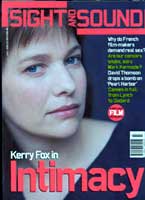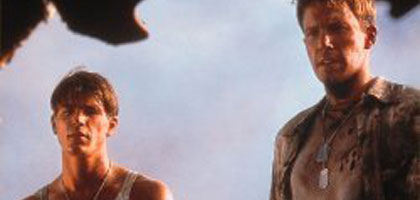
Pearl Harbour
USA 2001

Reviewed by Geoffrey Macnab
Synopsis
Our synopses give away the plot in full, including surprise twists.
Tennessee, 1923. On a farm, two kids, Rafe (Ben Affleck) and Danny (Josh Hartnett), clamber inside a crop-dusting plane and manage to take off. Danny's father (William Fichtner), a World War I veteran, is furious with them, but Rafe stands up for his friend.
January 1941. Rafe and Danny are pilots in the US Army Air Corps. Rafe falls in love with Evelyn Johnson (Kate Beckinsale), a nurse in the US Navy. He has to leave her when he volunteers for the Eagle Squadron, an American outfit fighting with the RAF during the Battle of Britain; he is shot down and is presumed dead.
By now both Danny and Evelyn are posted in Pearl Harbor, Hawaii. Stricken by Rafe's death, they turn to each other for solace and begin an affair. But Rafe turns up in Pearl Harbor alive, distressed to discover his best friend is having an affair with the woman he loves.
December 1941. The Japanese raid Pearl Harbor. The Americans are taken by surprise. The US Pacific Fleet is ripped to pieces and over 2,000 US soldiers are killed. Forgetting their rivalry, Rafe and Danny take to the skies and shoot down some of the Japanese planes.
Seeking redress, President Roosevelt (Jon Voight) responds enthusiastically to the idea of a bombing mission to Tokyo to be led by flying ace General Doolittle (Alec Baldwin). Both Rafe and Danny enlist. Rafe knows that Evelyn is pregnant with Danny's child. Danny is killed in action; Rafe makes it safely back.
Review
In tactical terms, the Japanese attack on Pearl Harbor on 7 December 1941, was a stunning success: 21 ships of the US Pacific Fleet were sunk or damaged, 2,403 Americans were killed and 1,178 wounded. The Japanese themselves suffered minimal losses. While many historians argue that the US and Japan would have gone to war anyway, the attack certainly accelerated the process - which makes Pearl Harbor a seismic moment in US history. Unfortunately, in his woeful $135 million summer blockbuster, Michael Bay fails to bring any insight to his treatment of the event.
Randall Wallace's screenplay crudely divides the action into three parts. The first 90 or so minutes are devoted to charting the friendship between two flyers, Rafe and Danny. They're all-American types with a strange resemblance to the characters played by Timothy Bottoms and Jeff Bridges in Peter Bogdanovich's The Last Picture Show (1971). They may be pilots posted in Hawaii, but their folksy, smalltown roots are established in a maudlin prologue which shows them as kids, flying a crop-dusting plane in 20s rural Tennessee. Just as in Bogdanovich's film, they get into a tangle over the same woman, Kate Beckinsale's svelte nurse Evelyn. Just as in producer Jerry Bruckheimer's 1986 effort Top Gun, the flyers seem as besotted with one another as they are with the woman who comes between them.
Happy with explosions, car chases and big set-pieces, Bay is far less assured when dealing with his protagonists' emotions. The early scenes, in which the soldiers court the nurses, are so leadenly handled you find yourself counting the moments until the Japanese planes arrive. Bay makes a few self-conscious nods towards Fred Zinnemann's From Here to Eternity (1953), also set around the time of the Japanese attack; he can't resist, for instance, a scene of Evelyn and Danny embracing on the beach as the waves lap around them. But such homages only point up the shallowness of the characterisation; instead of rounded, complex figures, all this film has to offer are clean-cut soldiers and off-duty nurses in floral dresses who behave as if they're on leave from a teen movie.
The attack itself seems like the excuse for making the movie: everything before it is flat, everything afterwards anti-climactic. In an essay on porn films, Umberto Eco once observed that normality must be established in as dull a way as possible before transgression can have any interest. (As he puts it: 'In porn movies, before you can see a healthy screw you have to put up with a documentary that could be sponsored by the traffic department.') Bay seems to be following the same principle in Pearl Harbor. Apart from a brief interlude when Rafe flies with the RAF in the Battle of Britain, the opening section seems deliberately deadpan, paving the way for us to enjoy all the more the 40 minutes of pyrotechnics when the Japanese invade. The problem is that after five minutes of this, we're already gorged on shots of bombs falling and ships toppling. The virtuosity of the special effects may be dazzling, the details historically accurate, but there is no more emotional charge than in any intergalactic shoot-out in Star Wars. The finale to the raid, in which Rafe and Danny take to the skies and shoot a few Japanese down as their colleagues whoop and holler below, is excessively jingoistic and risks trivialising the suffering of the victims - notably the sailors trapped in the hull of the sinking USS Arizona.
The film-makers don't even realise when they're shooting themselves in the foot. Cuba Gooding Jr's character, the African-American cook Dorie Miller, is especially misjudged. Treated with contempt by the navy bosses, he grabs a machine gun during the raid, an act of bravery that wins him a medal. But we learn little about this character; he feels like a token presence, as marginalised in the movie as the real-life Miller was in the racist, pre-Pearl Harbor navy.
In the final reel we're treated to a recreation of a daredevil US raid on Tokyo led by martinet flying ace General Doolittle. It's here the film slips irreversibly into a boy's-own fantasy. At certain moments, whenever grave-faced Roosevelt, played by Jon Voight, is rallying his generals or addressing the Senate, Bay strikes a sombre, portentous note. At other times, the mood is more akin to that of saccharine US television series The Wonder Years. 'America suffered but America grew stronger,' a sanctimonious voiceover tells us, as if Pearl Harbor was a rite of passage. Such cornball rhetoric may have a certain resonance for US audiences, but it is bound to grate wherever else this awful film is shown.
Credits
- Director
- Michael Bay
- Producers
- Jerry Bruckheimer
- Michael Bay
- Screenplay
- Randall Wallace
- Director of Photography
- John Schwartzman
- Editors
- Chris Lebenzon
- Steven Rosenblum
- Mark Goldblatt
- Roger Barton
- Production Designer
- Nigel Phelps
- Music
- Hans Zimmer
